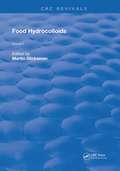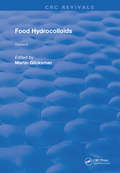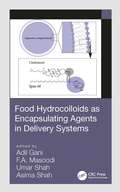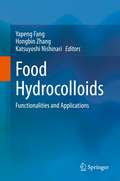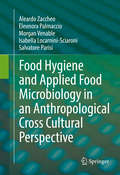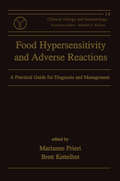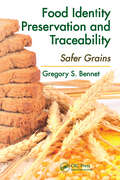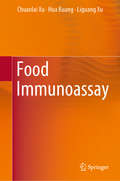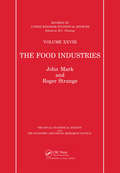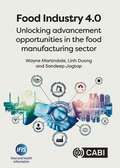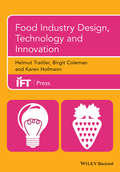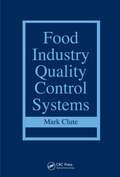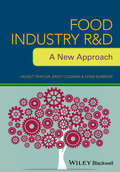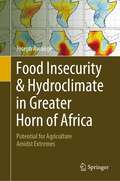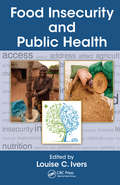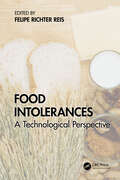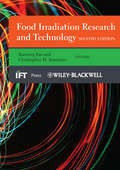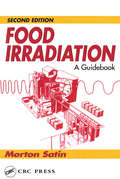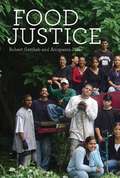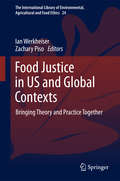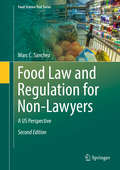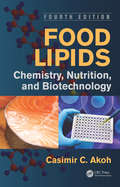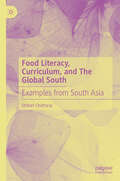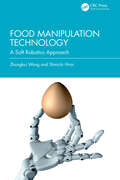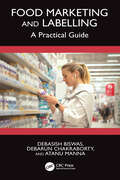- Table View
- List View
Food Hydrocolloids (Routledge Revivals #2)
by Martin GlicksmanFirst Published in 1982, this three-volume set explores the value of hydrocolloids in food. Carefully compiled and filled with a vast repertoire of notes, diagrams, and references this book serves as a useful reference for dieticians and other practitioners in their respective fields.
Food Hydrocolloids (Routledge Revivals #3)
by Martin Glicksman Steen Højgaard Christensen Joseph A. Grover Carl T. Herald John D. Keller Christopher McIntyre William R. ThomasFirst Published in 1982, this three-volume set explores the value of hydrocolloids in food. Carefully compiled and filled with a vast repertoire of notes, diagrams, and references this book serves as a useful reference for dieticians and other practitioners in their respective fields.
Food Hydrocolloids as Encapsulating Agents in Delivery Systems
by Adil Gani F. A. Masoodi Umar Shah Shah AsimaThis book addresses the use of food hydrocolloids as agents for encapsulating biological active ingredients. It details the challenges of poorly-controlled rate of hydration, thickness, decrease in viscosity upon storage, and susceptibility to microbial contamination. Food Hydrocolloids as Encapsulating Agents in Delivery Systems briefly describes various emerging biomaterials including food gums, starches, beta glucans, and proteins for their potential role as wall material in the development of nutraceutical delivery systems. Further, it describes different techniques of fabrication of nanodelivery systems. Features: Provides an introduction to food hydrocolloids as encapsulating agents Covers starches and their derivatives as delivery systems Includes gum-based delivery systems Discusses the classification, isolation, and purification of protein delivery systems This book would be helpful to food scientists and pharmaceutical scientists working in areas including nanotechnology, polymer chemistry, and nutraceutical delivery, as well as regulators and government researchers in US FDA, USDA, and UK FSA regulatory agencies.
Food Hydrocolloids: Functionalities and Applications
by Katsuyoshi Nishinari Yapeng Fang Hongbin ZhangThe book introduces the definition, classification, source and structure of hydrocolloids and provides a comprehensive description of their functionalities and food-related applications. The emphasis is put on the basic concepts and mechanisms underlying functionalities, and the new developments in fundamental knowledge and practice. The book would be useful for students or professionals working in the fields of food science & technology, and biopolymers etc. It would help to organize hydrocolloids knowledge in a more systematic framework and enlighten further profound investigations.
Food Hygiene and Applied Food Microbiology in an Anthropological Cross Cultural Perspective
by Salvatore Parisi Aleardo Zaccheo Eleonora Palmaccio Morgan Venable Isabella Locarnini-Sciaroni#65533;The book demonstrates that food safety is a multidisciplinary scientific discipline that is specifically designed to prevent foodborne illness to consumers. It is generally assumed to be an axiom by both nonprofessionals and professionals alike, that the most developed countries, through their intricate and complex standards, formal trainings and inspections, are always capable of providing much safer food items and beverages to consumers as opposed to the lesser developed countries and regions of the world. Clearly, the available data regarding the morbidity and the mortality in different areas of the world confirms that in developing countries, the prevalence and the incidence of presumptive foodborne illness is much greater. However, other factors need to be taken into consideration in this overall picture: First of all, one of the key issues in developing countries appears to be the availability of safe drinking water, a key element in any food safety strategy. Second, the availability of healthcare facilities, care providers, and medicines in different parts of the world makes the consequences of foodborne illness much more important and life threatening in lesser developed countries than in most developed countries. It would be therefore ethnocentric and rather simplistic to state that the margin of improvement in food safety is only directly proportional to the level of development of the society or to the level of complexity of any given national or international standard. Besides standards and regulations, humans as a whole have evolved and adapted different strategies to provide and to ensure food and water safety according to their cultural and historical backgrounds. Our goal is to discuss and to compare these strategies in a cross-cultural and technical approach, according to the realities of different socio-economic, ethnical and social heritages.
Food Hypersensitivity and Adverse Reactions: A Practical Guide for Diagnosis and Management
by Marianne FrieriPresents classic and recent findings on immunological dysfunctions caused by food allergies-coordinating the most advanced clinical techniques and assessment methods with practical insights for treatment and patient care.
Food Identity Preservation and Traceability: Safer Grains
by Gregory S. BennetA Practical Roadmap to IPT IntegrationFrom baby formula and peanut butter, to E. coli-tainted peppers and salmonella-tainted pistachios, no food product or means of its production is immune to risks. And while these risks may never be fully eliminated, identity preservation and traceability (IPT) systems make it easier to determine the source and e
Food Immunoassay
by Chuanlai Xu Hua Kuang Liguang XuThis book systematically covers immunoassays for food, presenting detailed approaches such as antigen design, food matrix pre-treatment and detection format optimization for 9 classes of food hazards and nutrition constituents. Offering ideas on how to improve the efficiency of recognized xenobiotics and food contents, this practical book also describes the discovery and utilization of novel immune agents like aptamer and molecular imprinted polymers in food analysis. It is intended for a broad range of areas, including biologists and food chemists, and is sure to become a key reference resource for students and professionals alike.
Food Industries
by J. Mark R. Strange J. BurnsThis volume deals with the diverse range of industries concerned with the supply and processing of food in the UK. It covers sources relating to food production and processing, including foodstuffs supplied from abroad, and also fish supply and processing.
Food Industry 4.0: Unlocking Advancement Opportunities in the Food Manufacturing Sector
by Dr Wayne Martindale Dr Linh Duong Dr Sandeep JagtapThis book provides industry insights and fresh ideas for the advancement of the most vital global industry - food. Drawing on their industry and academic expertise the authors have identified three controlling aspects of food business operations that can unleash long term success: consumer health and wellbeing; product and process sustainability; and harnessing advances in digitalization.. If developed to their maximum potential these factors have the capability to revolutionize the food sector. Food Industry 4.0 highlights advancement opportunities for the food manufacturing sector, including innovation in products, processes and services, as it seeks to combine productive, efficient and sustainable practices. The contents address: Mapping data, new approaches for food system applications. The perfect meal and making a balanced global diet possible. Industry 4.0 applications in the food sector: robotics and automation, big data, Internet of Things, cybersecurity. Resource utilization in the food manufacturing sector. Resilience and sustainability in food supply chains. Environmental and social governance in our food system. It is of significant benefit to food industry practitioners working in operational and product development roles, academic researchers, policy makers, students, and food sector professionals.
Food Industry Design, Technology and Innovation
by Helmut Traitler Birgit Coleman Karen HofmannFood products have always been designed, but usually not consciously. Even when design has been part of the process, it has often been restricted to considerations of packaging, logos, fonts and colors.But now design is impacting more dramatically on the complex web that makes up our food supply, and beginning to make it better. Ways of thinking about design have broad applications and are becoming central to how companies compete. To succeed, food designers need to understand consumers and envision what they want, and to use technology and systems to show they can deliver what has been envisioned. They also need to understand organizations in order to make innovation happen in a corporation.The authors of this book argue that design has been grossly underestimated in the food industry. The role of design in relation to technology of every kind (materials, mechanics, ingredients, conversion, transformation, etc.) is described, discussed, challenged and put into proper perspective. The authors deftly analyze and synthesize complex concepts, inspiring new ideas and practices through real-world examples. The second part of the book emphasizes the role of innovation and how the elements described and discussed in the first parts (design, technology, business) must join forces in order to drive valuable innovation in complex organizations such as large (and not so large) food companies.Ultimately, this groundbreaking book champions the implementation of a design role in defining and executing business strategies and business processes. Not only are designers tremendously important to the present and future successes of food corporations, but they should play an active and decisive role at the executive board level of any food company that strives for greater success.
Food Industry Quality Control Systems
by Mark CluteWith more than 100 tables, spreadsheets, and program outlines, Food Industry Quality Control Systems features all of the systems needed for food manufacturing facilities to assure food quality and safety. This book outlines the role of management in overall quality control and the role of HACCP within a company. It explains the basics of quality control programs including pest control programs, lot coding, organizational charts, specifications, supplier certification, and sanitation programs. Readers can visit the CRC website to download supporting programs in a "plug-and-play" format and adaptable forms with specific examples and resources that enable companies to customize forms to fit their own needs.
Food Industry R&D: A New Approach
by Helmut Traitler Birgit Coleman Adam BurbidgeResearch and development represents a vast spread of topics and can be an arena for controversy. In academia, such controversy may stem from conflicting interpretations of data and subsequent conclusions, the question of who was first to discover a particular finding and whether or not the said finding is of any value to the scientific community. R&D in corporate environments is mostly defined and driven by costs and clearly identified, consumer-focused targets. There is, however, common ground between these two approaches as both strive to maximize knowledge, though for different reasons and in differnt ways. The equipment and scientific rigor may be similar or identical, however their usage, approach and interpretation are different. This book discusses the history and background of today's food industry R&D as seen by consumers, academia and the industry itself, with several chapters dedicated to new and disruptive approaches. A must-read for all professionals in the packaged goods industry as well as students who aspire to contribute to this new industry, forcefully driven by R&D.
Food Insecurity & Hydroclimate in Greater Horn of Africa: Potential for Agriculture Amidst Extremes
by Joseph AwangeThis book will benefit users in food security, agriculture, water management, and environmental sectors. It provides the first comprehensive analysis of Greater Horn of Africa (GHA)’s food insecurity and hydroclimate using the state-of-the-art Gravity Recovery and Climate Experiment (GRACE) and its Follow-on (GRACE-FO)’s, centennial precipitation, hydrological models’ and reanalysis’ products. It is here opined that GHA is endowed with freshwater (surface and groundwater) being home to the world's second largest freshwater body (Lake Victoria) and the greatest continental water towers (Ethiopian Highlands) that if properly tapped in a sustainable way, will support its irrigated agriculture as well as pastoralism. First, however, the obsolete Nile treaties that hamper the use of Lake Victoria (White Nile) and Ethiopian Highland (Blue Nile) have to be unlocked. Moreover, GHA is bedevilled by poor governance and the ``donor-assistance” syndrome; and in 2020-2021 faced the so-called ``triple threats’’ of desert locust infestation, climate variability/change impacts and COVID-19 pandemic. Besides, climate extremes influence its meagre waters leading to perennial food insecurity. Coupled with frequent regional and local conflicts, high population growth rate, low crop yield, invasion of migratory pests, contagious human and livestock diseases (such as HIV/AIDs, COVID-19 & Rift Valley fever) and poverty, life for more than 310 million of its inhabitants simply becomes unbearable. Alarming also is the fact that drought-like humanitarian crises are increasing in GHA despite recent progress in its monitoring and prediction efforts. Notwithstanding these efforts, there remain challenges stemming from uncertainty in its prediction, and the inflexibility and limited buffering capacity of the recurrent impacted systems. To achieve greater food security, therefore, in addition to boosting GHA's agricultural output, UN Office for the Coordination of Humanitarian Affairs suggest that its “inhabitants must create more diverse and stable means of livelihood to insulate themselves and their households from external shocks”. This is a task that they acknowledge will not be easy as the path ahead is “strewn with obstacles namely; natural hazards and armed conflicts”. Understanding GHA’s food insecurity and its hydroclimate as presented in this book is a good starting point towards managing the impacts of the natural hazards on the one hand while understanding the impacts associated with extreme climate on GHA's available water and assessing the potential of its surface and groundwater to support its irrigated agriculture and pastoralism would be the first step towards “coping with drought” on the other hand.The book represents a significant effort by Prof Awange in trying to offer a comprehensive overview of the hydroclimate in the Greater Horn of Africa (GHA). Prof Eric F. Wood, NAE (USA); FRSC (Canada); Foreign member, ATSE (Australia).
Food Insecurity and Public Health
by Louise IversAffecting more than 800 million people, food insecurity is a global problem that runs deeper than hunger and undernutrition. In addition to the obvious impact on physical well-being, food insecurity can result in risky coping strategies, increased expenditures on medical costs or transportation, and mental health issues. A review of the concepts an
Food Intolerances: A Technological Perspective
by Felipe Richter ReisWhile modern food production has become increasingly efficient in providing a wide range of convenient and affordable products, individuals struggling with gluten intolerance, FODMAP intolerance, and intolerance to food additives are an exception when their health conditions limit the foods they can safely eat. Food intolerances, usually dealt with from a health perspective, also have technological aspects, especially as one takes into consideration that foods designed for individuals with food intolerances require specific ingredients, formulations, and processing conditions.Food Intolerances: A Technological Perspective addresses the health and food science aspects of food intolerances from a technological perspective, which is rarely considered in other books. Valuable data on products and production processes for designing foods for people who have food intolerances are presented in a way that various types of food industries can benefit from.Key Features: Compiles health and food science aspects of food intolerances in a single location Addresses clean label food products and links them to food additive intolerances Discusses the mechanisms behind the changes in food product quality after ingredient substitution and compound removal in gluten-free, low-FODMAP, and clean label products Provides perspectives and future trends in the development of food products for people who have food intolerances A compilation of research from prominent medical doctors and PhDs in food science from around the world, this book is helpful for food science students and industry professionals alike.
Food Irradiation Research and Technology (Institute of Food Technologists Series #68)
by Christopher H. Sommers Xuetong FanThe benefits of food irradiation to the public health have been described extensively by organizations such as the Centers for Disease Control and Prevention in the USA and the World Health Organization. The American Medical Association and the American Dietetic Association have both endorsed the irradiation process. Yet the potential health benefits of irradiation are unknown to many consumers and food industry representatives who are wary of irradiated foods due to myth-information from “consumer-advocate” groups. This updated second edition of Food Irradiation Research and Technology reviews the latest developments in irradiation technologies as they are applied to meat, seafood fish, fruits, vegetables and nuts. Experts from industry, government, and academia define the basic principles and public health benefits of irradiation. New chapters in this edition address irradiation chemistry, including furan formation due to irradiation, irradiation of packaging materials, processing irradiation technologies and parameters, and ready-to-eat meat products. Coverage of safety and quality of fresh fruits and vegetables, phytosanitary applications and consumer acceptance has been expanded to address recent interest and development. The book is designed to appeal to a broad readership: industry food scientists involved in the processing of meat and fish, fruits and vegetables; food microbiologists and radiation processing specialists; and government and industry representatives involved in the import and export of food commodities.
Food Irradiation: A Guidebook, Second Edition
by Morton SatinFood irradiation has been in the news lately, and this news strongly favors the consideration of food irradiation as a practical, economical method for improving food safety and shelf life. This new edition of a popular guidebook provides an updated, detailed, readable survey of the past, present and future of food irradiation. It covers a wide variety of topics ranging from the scientific basics to an examination of the many objections to food irradiation. Also included is a detailed discussion of the role of food irradiation in preventing a variety of foodborne diseases.
Food Justice
by Robert Gottlieb Anupama JoshiIn today's food system, farm workers face difficult and hazardous conditions,low-income neighborhoods lack supermarkets but abound in fast-food restaurants and liquor stores,food products emphasize convenience rather than wholesomeness, and the international reach ofAmerican fast-food franchises has been a major contributor to an epidemic of "globesity. "To combat these inequities and excesses, a movement for food justice has emerged in recent yearsseeking to transform the food system from seed to table. In Food Justice, RobertGottlieb and Anupama Joshi tell the story of this emerging movement. A foodjustice framework ensures that the benefits and risks of how food is grown and processed,transported, distributed, and consumed are shared equitably. Gottlieb and Joshi recount the historyof food injustices and describe current efforts to change the system, including community gardensand farmer training in Holyoke, Massachusetts, youth empowerment through the Rethinkers in NewOrleans, farm-to-school programs across the country, and the Los Angeles school system's eliminationof sugary soft drinks from its cafeterias. And they tell how food activism has succeeded at thehighest level: advocates waged a grassroots campaign that convinced the Obama White House to plant avegetable garden. The first comprehensive inquiry into this emerging movement, FoodJustice addresses the increasing disconnect between food and culture that has resultedfrom our highly industrialized food system.
Food Justice in US and Global Contexts
by Ian Werkheiser Zachary PisoThis book offers fresh perspectives on issues of food justice. The chapters emerged from a series of annual workshops on food justice held at Michigan State University between 2013 and 2015, which brought together a wide variety of interested people to learn from and work with each other. Food justice can be studied from such diverse perspectives as philosophy, anthropology, economics, gender and sexuality studies, geography, history, literary criticism, philosophy and sociology as well as the human dimensions of agricultural and environmental sciences. As such, interdisciplinary workshops are a much-needed vehicle to improve our understanding of the subject, which is at the center of a vibrant and growing discourse not only among academics from a wide range of disciplines but also among policy makers and community activists. The book includes their perspectives, offering a wide range of approaches to and conceptions of food justice in a variety of contexts. This invaluable work requires readers to cross boundaries and be open to new ideas based on different assumptions.
Food Law and Regulation for Non-Lawyers: A Us Perspective (Food Science Text Ser.)
by Marc C. SanchezDesigned and modeled after a six-week introductory food law course taught at Northeastern University, Food Law and Regulation for Non-Lawyers offers a succinct overview of key topics and core concepts for food scientists, quality managers, and others who need to understand the regulation of food in the U.S. This second edition includes critical updates on the Food Safety Modernization Act-- the first change to the food safety laws in over 70 years. The seven foundational rules, finalized in 2015, are discussed in detail. The new edition also includes other regulatory updates such as the new Nutrition Fact Panel, changes to the definition of fiber, and the FDA’s attempt to regulate the widely used “healthy” claim. These timely updates, along with the core concepts of the first edition, make the volume an essential and practical tool for regulatory professionals.
Food Lipids: Chemistry, Nutrition, and Biotechnology, Fourth Edition
by Casimir C. AkohMaintaining the high standards that made the previous editions such well-respected and widely used references, Food Lipids: Chemistry, Nutrition, and Biotechnology, Fourth Edition provides a new look at lipid oxidation and highlights recent findings and research. Always representative of the current state of lipid science, this edition provides 16 new chapters and 21 updated chapters, written by leading international experts, that reflect the latest advances in technology and studies of food lipids.New chapters Analysis of Fatty Acid Positional Distribution in Triacylglycerol Physical Characterization of Fats and Oils Processing and Modification Technologies for Edible Oils and Fats Crystallization Behavior of Fats: Effect of Processing Conditions Enzymatic Purification and Enrichment and Purification of Polyunsaturated Fatty Acids and Conjugated Linoleic Acid Isomers Microbial Lipid Production Food Applications of Lipids Encapsulation Technologies for Lipids Rethinking Lipid Oxidation Digestion, Absorption and Metabolism of Lipids Omega-3 Polyunsaturated Fatty Acids and Health Brain Lipids in Health and Disease Biotechnologically Enriched Cereals with PUFAs in Ruminant and Chicken Nutrition Enzyme-Catalyzed Production of Lipid Based Esters for the Food Industry: Emerging Process and Technology Production of Edible Oils Through Metabolic Engineering Genetically Engineered Cereals for Production of Polyunsaturated Fatty Acids The most comprehensive and relevant treatment of food lipids available, this book highlights the role of dietary fats in foods, human health, and disease. Divided into five parts, it begins with the chemistry and properties of food lipids covering nomenclature and classification, extraction and analysis, and chemistry and function. Part II addresses processing and food applications including modification technologies, microbial production of lipids, crystallization behavior, chemical interesterification, purification, and encapsulation technologies. The third part covers oxidation, measurements, and antioxidants. Part IV explores the myriad interactions of lipids in nutrition and health with information on heart disease, obesity, and cancer, with a new chapter dedicated to brain lipids. Part V continues with contributions on biotechnology and biochemistry including a chapter on the metabolic engineering of edible oils.
Food Literacy, Curriculum, and The Global South: Examples from South Asia
by Dishari ChattarajThis volume explores concepts and theories of food literacy to understand the interdisciplinary paradigms, perspectives, and emerging discourses in and beyond formal educational contexts in the Global South, specifically South Asia. In doing so, this volume provides a comprehensive overview of existing literature on food literacy and the methodologies utilized to study the same across the Global North and South. Furthermore, this volume reports the findings of a primary research study conducted in the domain of curriculum analysis across school education boards of six South Asian countries, including Bangladesh, Bhutan, India, Nepal, and Sri Lanka. It also documents the teaching-learning experiences and perceptions of various stakeholders from select schools and regions in India. Besides highlighting the dynamic, contextual, and place-based nature of food literacies, the volume questions the autonomous nature of literacy studies, thereby promoting a less deterministic and more sustainable, inclusive, and discursive paradigm of food literacy/literacies.
Food Manipulation Technology: A Soft Robotics Approach
by Shinichi Hirai Zhongkui WangWang and Hirai draw on their extensive experience to introduce recent technological advances in soft robotics for food manipulation and discuss their practical applications in the food preparation industry. They also describe food modeling and categorization for the purpose of robotic handling.Food manipulation is common in restaurants, kitchens, and food factories, but it currently largely relies on humans because of the lack of effective robotic systems. This book therefore explains recent manipulation technology for food handling and restaurant/kitchen automation, which is essential for food manipulation. The book covers the theoretical background of soft robotic hands; their application to different handling purposes in the food industry; their use in kitchen and restaurant automation; and their use for food recognition, property measuring, and modeling. The authors also present case studies of the development of soft robotic hands to illustrate the information and provide practical information that will be instructional for readers. Readers will gain an in-depth appreciation of the technology and its practical application to industry, which will enable them to implement this in their own work.This book is an essential read for both food technology practitioners and graduate students who are interested in food manipulation and its related technologies. It gives readers the theoretical background knowledge and practical understanding to apply this cutting-edge technology in real-world settings.
Food Marketing and Labelling: A Practical Guide
by Debasish Biswas Debarun Chakraborty Atanu MannaThis book provides in-depth coverage of the interconnection among food marketing, labelling, and technology to enhance consumers’, practitioners’, and scholars’ understanding of the modern food market. In 14 chapters, it explores the marketing, labelling, and technological aspects of the food industry. It briefly discusses crucial aspects of food marketing, from consumer preferences and branding strategies to regulation in food labelling, technological advancement, and sustainable practices. It allows readers to understand the holistic view of food marketing, labelling, and technology and their interrelationship. Throughout, it includes several case studies and practical examples.Key Features Analyses consumer psychology behind food choice and marketing strategy Covers food labelling regulations and compliance and nutritional requirements extensively Includes sustainable and ethical dimensions of food marketing, labelling, and technology for guiding readers on responsible practices
